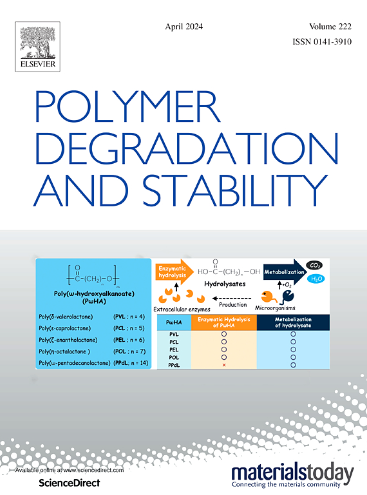Thermal ageing of PP-EPDM thermoplastic vulcanizate: Multiscale study and kinetic modeling
IF 7.4
2区 化学
Q1 POLYMER SCIENCE
引用次数: 0
Abstract
This work presents a multi-scale study of the impact of thermal ageing of thermoplastic vulcanizate (TPV) obtained by blending a thermoplastic matrix (polypropylene), plasticizer, and dispersed crosslinked EPDM rubber particles. This study focuses on the case of TPV without pigments or stabilizers. The thermal ageing was mainly monitored by Fourier transform infrared and thermal analysis, to identify oxidation products and their kinetics of appearance, and GPC analysis performed on extracted PP fraction of the TPV. Data indicated that EPDM phase oxidizes first which drives degradation of the TPV. Appearance changes were characterized by colorimetry and gloss. Oxidation leads to strong changes of mechanical properties and aspect properties observed from the early hours of ageing, yellowing (change of Δb*) being also induced by the plasticizer. Yellowing reached unacceptable level (regarding the requirements for exterior automotive parts) before mechanical properties. The oxidation of EPDM and TPV was thus simulated by a kinetic model based on kinetic parameters already available in the literature. Its validity was verified by its capability to simulate the appearance of primary (hydroperoxides) and secondary (carbonyls) oxidation products.
PP-EPDM热塑性硫化胶的热老化:多尺度研究和动力学建模
这项工作提出了热塑性硫化胶(TPV)的热老化影响的多尺度研究,该硫化胶是由热塑性基质(聚丙烯)、增塑剂和分散交联三元乙丙橡胶颗粒混合而成的。本研究的重点是TPV无色素或稳定剂的情况下。热老化主要通过傅里叶变换红外和热分析来监测,以识别氧化产物及其外观动力学,并对TPV提取的PP部分进行GPC分析。数据表明,EPDM相首先氧化,从而驱动TPV的降解。用比色法和光泽度表征外观变化。氧化导致从老化初期观察到的机械性能和外观性能的强烈变化,增塑剂也引起黄变(Δb*的变化)。在机械性能之前,黄变达到了不可接受的水平(关于汽车外饰件的要求)。因此,EPDM和TPV的氧化通过基于文献中已有的动力学参数的动力学模型进行了模拟。通过模拟一次(氢过氧化物)和二次(羰基)氧化产物的外观,验证了其有效性。
本文章由计算机程序翻译,如有差异,请以英文原文为准。
求助全文
约1分钟内获得全文
求助全文
来源期刊

Polymer Degradation and Stability
化学-高分子科学
CiteScore
10.10
自引率
10.20%
发文量
325
审稿时长
23 days
期刊介绍:
Polymer Degradation and Stability deals with the degradation reactions and their control which are a major preoccupation of practitioners of the many and diverse aspects of modern polymer technology.
Deteriorative reactions occur during processing, when polymers are subjected to heat, oxygen and mechanical stress, and during the useful life of the materials when oxygen and sunlight are the most important degradative agencies. In more specialised applications, degradation may be induced by high energy radiation, ozone, atmospheric pollutants, mechanical stress, biological action, hydrolysis and many other influences. The mechanisms of these reactions and stabilisation processes must be understood if the technology and application of polymers are to continue to advance. The reporting of investigations of this kind is therefore a major function of this journal.
However there are also new developments in polymer technology in which degradation processes find positive applications. For example, photodegradable plastics are now available, the recycling of polymeric products will become increasingly important, degradation and combustion studies are involved in the definition of the fire hazards which are associated with polymeric materials and the microelectronics industry is vitally dependent upon polymer degradation in the manufacture of its circuitry. Polymer properties may also be improved by processes like curing and grafting, the chemistry of which can be closely related to that which causes physical deterioration in other circumstances.
 求助内容:
求助内容: 应助结果提醒方式:
应助结果提醒方式:


